Paper: On the Circumstellar Medium of Massive Stars and how it may appear in GRB Observations
Authors: A.J. van Marle, R. Keppens, S.-C. Yoon, and N. Langer
First Author’s Institution: Centre of Plasma Astrophysics, Heverlee, Belgium
Today’s article is of a slightly different nature than usual: a conference proceeding. Although conferences come in many shapes, sizes and formats, several of the smaller astrophysics conferences I have attended invite those who speak to submit a written summary of their talk. These are then compiled together and published (sometimes up to a year after the conference occurred, depending how strict the organizers were about pesky little things like deadlines…). Conference proceedings can often be more comprehensible than journal publications and therefore provide a great starting point when jumping into a new field. Today’s article will appear in the proceedings of “GRBs as probes: from the progenitor’s environment to the high redshift Universe”, a Gamma-Ray Burst Conference that was held in Lake Como, Italy this past May. In their talk the authors focused on the question: how can the medium immediately surrounding massive stars affect our observations of Gamma-Ray Bursts (GRBs)?
So what do massive stars have to do with GRBs? GRBs come in two different flavors: long and short. The current leading model for long-duration GRBs is that they arise during the death of massive stars (for a number of reasons, including their apparent connection to Supernova).
So what do the immediate environments around these stars have to do with GRBs? Massive stars are known to possess enormous stellar winds which expel large fractions of their initial mass over the course of their evolution. The detailed history of this wind, which will be different for different types of stars, can therefore have a large effect on the structure of the circumstellar medium. This is the same medium that a GRB would have to pass through to reach us. Its detailed structure may therefore have noticeable effects on our observations, either through absorption of some of the afterglow emission, or by affecting the evolution of the jet when it collides with dense parts of the medium.
So here is the idea: Take several different potential GRB progenitors (the objects which lead to GRBs, e.g. rapidly rotating isolated star vs. binaries). Model the circumstellar medium around these stars. If there are differences, assess how/if they would manifest themselves in observations. This is what the authors are in the process of doing.
In this article, they present results from a hydrodynamical model of the environment around a rapidly rotating isolated star. They start with the results from an existing code of the evolution of a 16 solar mass star with high initial rotation. This provides them with a mass-loss rate, wind velocity, and rotation rate (as a function of time) which they use as inputs for their hydrodynamical code. The hydrodynamical code then numerically solves the equations of mass, momentum, and energy conservation on a moving mesh. They run the simulation with two different assumptions for the underlying density to represent (i) the general interstellar medium and (ii) dense molecular clouds in which many stars form.
Examples of their results are shown in the figures to the right (darker colors represent high density and the star is located at the origin). They find in both cases their models show a large bubble of wind-swept and shocked material (the white outer ring). In the low density case, however, the edge of this bubble lies much closer to the star. There is also quite a bit of structure within this outer shell, as changes in mass-loss rate and rotation can cause bipolar shells to be ejected (material is sent preferentially towards the poles) at various velocities. Look closely at the figures, though. In the low density, intermediate time snapshot, an interior shell is still present, whereas in the low density environment it has already collided with the outer bubble (because the outer bubble is smaller) and started to dissipate. The result is that, at the end of their lives, the environment immediately surrounding the star in a low density environment is much more turbulent than for a star in a high density environment.
The authors therefore demonstrate that the density of the interstellar medium, as well as the type of progenitor, plays a large role in the shaping the structure of the medium immediately surrounding potential GRB progenitors.

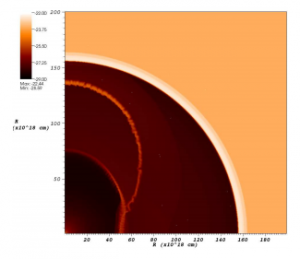
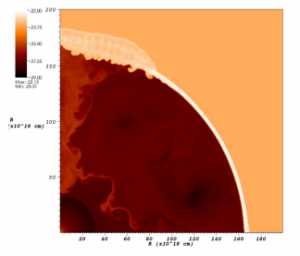

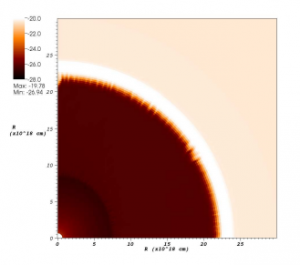


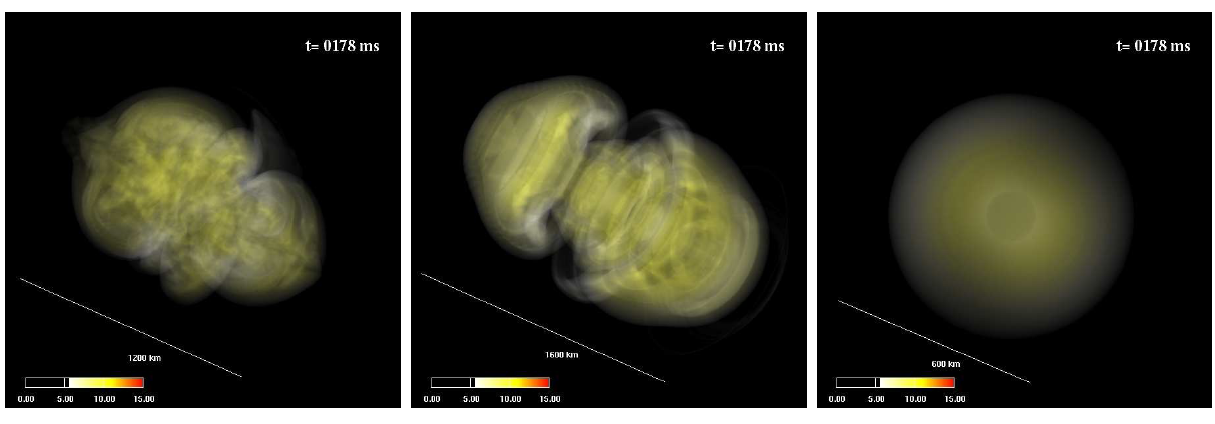
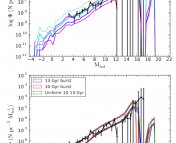
Pretty interesting! It’s a weird coincidence that this was posted just as I found out that I’ll be working with the authors of this paper in a few months…